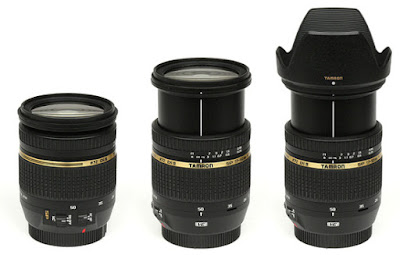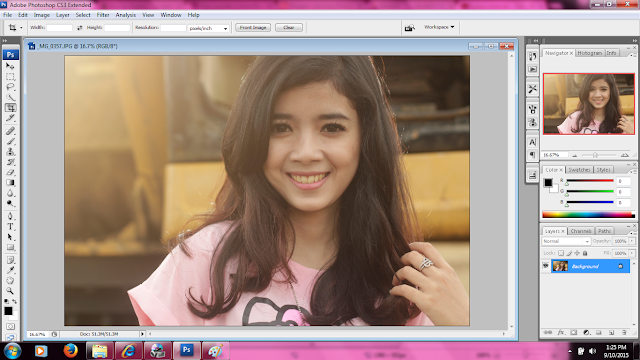LEARN TO ANALYZE THE LENS CAMERA LENS WHEN YOU BUY
Hallo guys !!
Maybe for those who are new to the world of photography is very confusing when choosing a good lens for use, one type of lens below.
Tamron AF 17-50mm f / 2.8 SP XR Di II LD Aspherical [IF] VC
No one knows what the meaning of each name at the top? Very long! And filled with stands! More dizziness again, each lens manufacturers use different terms to say the same thing .. So even if we already know the meaning of terms Tamron lens, for example, we will still see the term confusion Sigma lenses! Or any other brand lenses.
Let's get on with it!
Through this article I tried to explain what are the specifications that could exist in the lens, and its use. Unfortunately I have not memorized the term used each lens manufacturers to label their lenses, so maybe you need to browse alone to see the list of terms used to refer to the specification described here. Because too many different names used by each lens producers, such as sigma and tamfron.
1. Focal length (real and equivalent)

Focal length is the distance of the focus point of the lens. This affects the width of the field of view lens (FL equivalents), thick sharp space (FL real), and the ratio of the size of objects that are different distances from the lens (FL equivalent). The bigger the FL lens, the field of view will be more narrow (as if we approach the object), depth of field will be more narrow (in distance and aperture are the same), and objects distant (background) will look more similar in size to the object -benda near (foreground or main object). The equation is the size commonly referred to as (effect) compression: because objects behind the visible size is not too different from the object in front, they look as if it is closer to one another. That's according to the professionals different again with the commonly used definition of a layman, the lens 'zoom' means that the lens has a varied FL. For example, as the above example, FL has a 17-50mm. A lens that can make us as if approaching object is called a telephoto lens (FFL), and telephoto lenses usually have FL 135mm upwards. On the other hand, could have a telephoto lens is also a zoom lens, for example 150-500mm lens with FL (large FLnya = tele, FLnya vary = zoom). The opposite of tele is wide (wide field of view, small FL).
What does that mean in real FL and equivalents? FL Real means that number refers to the focal distance of the lens itself. FL equivalent of a lens refers to a lens whose focal distance when mounted on fullframe cameras will have a field of view (field of view) are the same as the lens (if installed in the camera).
For example: a 50mm lens when mounted on a camera Olympus PEN will have the same field of view with a 100mm lens on fullframe cameras. Then, a 50mm lens FL is said to have the equivalent of 100mm on the Olympus PEN cameras. Multiplier (2x) is called "crop factor", which is influenced by the size of the camera sensor.
But in my experience that the lens does not have the result sharper FL that in my opinion does ya hehe
2. Aperture / maximum aperture
Most lenses can write a maximum aperture of the lens used. For example, the kit lens / standard DSLR usually have a spec 18-55mm, f / 3.5 - 5.6. This specification means that the lens has a range of between 18mm to 55mm FL. In the FL 18mm, the lens has a maximum aperture of f / 3.5; in the FL 55mm lens has a maximum aperture of f / 5.6.
If a zoom lens has only one aperture numbers are written down, meaning the zoom lens has a maximum aperture the same, F / 3.5 indicates that a minimum aperture of the lens, the lens has a very small aperature the bokeh effect to any better.
3. Crop factor
As described above, the camera has a crop factor. For most brands of DSLR, there are only two types of cameras: fullframe (no crop factor, or crop factor 1x) and APS-C which has a 1.5x crop factor (Nikon, Sony, Pentax), or 1.6x (Canon). Fullframe cameras have a sensor size that is larger than the APS-C. Therefore, the lenses used would be different.
Fullframe lens produces images that are wider in the fields of sensors, while the APS-C lens produces images more narrow, and only enough to cover the field of APS-C sensor only. Therefore, fullframe lenses can be used on an APS-C camera, but the lens APS-C can not be used on fullframe cameras. If the APS-C lenses used in cameras fullframe, then the result will be vignetting (no black around the photo), because the lens only produce images in the central part of the fullframe sensor field. Not all lenses are suitable for your camera, consider the special lenses for camera 5D Mark III, does not fit mounted to the camera 1100 D if even then canon there is also nikon types are specified, the point if you buy a lens adjusted first to the needs in the camera your own whether compataible or not.
Lens crop factor of APS-C vs. This fullframe written as: EF-S vs EF (Canon), DX vs. FX (Nikon), Di II vs Di (Tamron), etc.
4. Silencer vibration
Some lenses have a vibration dampening mechanism. If we hold the camera by hand, the camera will inevitably sway, albeit slightly. In a slow shutter speed, wobble will be visible in the photo. This mechanism allows the lens elements to move against the direction of oscillation / vibration our hands, thus eliminating judder effect seen in the photo.
Most vibration dampening mechanism reduces vibration up to 2 stops, which means the rocking effect will be reduced so that it looks as if we are shooting with a 4x faster shutter speed (the same as the second stop). Lenses can we take the example of a football photographer if not wearing a monopod, photgrafer racing cars and others.
This mechanism is called the IS (Canon), VR (Nikon), VC (Tamron), OS (Sigma), OSS (Sony E), etc.
5. Motor / focusing mechanism
Many manufacturers of lenses use focusing mechanism different motors in their lenses. If a lens using a good mechanism, usually this will be included in the name of the lens. Good mechanism usually means the lens will be faster when autofocusing, and his voice was more subtle.
This mechanism is called the USM (Canon), SWM (Nikon), USD / PZD (Tamron), HSM (Sigma), SSM (Sony), and so on.
but also to adjust your camera, if you're a Canon 550 D camera and compared with canon 5D mark III is definitely more subtle canon 5D mark III hehehe. The point is to understand the theory and clay fact we have a camera like.
6. Internal focusing
The lens will typically rotates and extends / short while focusing. Internal focusing means the lens does not extend / short or rotating during focusing. This is useful when you use a filter that needs to be used with angle
Similarly, for example, GND or CPL that the photos you become more dramatic.
7. Rear focusing
The term means the rear focusing lens in the lens perform focusing by moving the rear element. This resulted in focusing becomes faster and smoother.
Until this point, virtually all important spec lenses that you already know. Subsequent terms only refer to the technology used in optical elements. The technology is very influential on the result of your photograph.
8. Aspherical element
Aspherical lens element indicates that the use of optical elements whose shape is not round. This reduces the effect of convex on the image, and also enables a more compact lens design and quality. Usually the lens above 1000 USD were like this.
9. Low Dispersion
Have you ever seen a purplish color (usually) on the edge of the bright areas / white in your photos? It is called color fringing or color aberration (CA). Low dispersion indicates that the lens has a CA that is less than a lens that does not have a low dispersion. The point is customized to the needs of each, sometimes human tastes different.
photography may be useful forward world!



















































